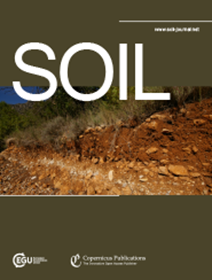What is the stability of additional organic carbon stored thanks to alternative cropping systems and organic wastes products application? A multi-methods evaluation
IF 5.8
2区 农林科学
Q1 SOIL SCIENCE
引用次数: 0
Abstract
Abstract. The implementation of agroecological practices often leads to an additional soil organic carbon storage in these soils, of which we aimed to assess the biogeochemical stability. To achieve this, we implemented a multi-method approach using particles size and density fractionation, Rock-Eval® thermal analyses and long-term incubation (484 days), that we applied to topsoil samples (0–30 cm) from temperate luvisols that had been subjected, in > 20 years long-term experiments in France, to conservation agriculture (CA), organic agriculture (ORG) and conventional agriculture (CON-LC) in La Cage experiment, and to organic wastes products (OWPs) applications in QualiAgro experiment, including biowaste composts (BIOW), residual municipal solid waste composts (MSW), farmyard manure (FYM) and conventional agriculture without organic inputs (CON-QA). The incubations provided information on the additional carbon stability in the short term (i.e., MRT <2 years) and showed that the additional soil organic C mineralized faster than the baseline C at La Cage but slower at QualiAgro. In OWPs-treated plots at QualiAgro, 60–66 % of the additional carbon was stored as mineral-associated organic matter (MAOM-C), and 34–40 % as particulate organic matter (POM-C). In CA and ORG systems at La Cage, 77–84 % of the additional carbon was stored in MAOM-C, versus 16–23 % as POM-C. Management practices hence influenced the distribution of additional carbon in physical fractions. Utilizing the PARTYSOC model with Rock-Eval® thermal analysis parameters, we found that most, if not all, of the additional carbon belonged to the active carbon pool (MRT ~ 30–40 years). In summary, our comprehensive multi-methods evaluation indicates that the additional soil organic carbon is less stable over decadal and pluri-decadal time-scales compared to soil carbon under baseline practices. Our results show that particle size and density fractions can be heterogenous in their biogeochemical stability. On the one hand, while additional carbon was mainly associated with MAOM, we suggest that it has a mean residence time exceeding ~30 years, rather than of ≈ 50 years. On the other hand agroecological practices with equivalent additional carbon stocks (MSW, FYM vs CA) exhibited a higher proportion of additional carbon in POM-C under MSW (40 %) and FYM (34 %) compared to CA (16 %), which suggests a high chemical recalcitrance of POM-C under OWPs management relative to CA. Additional soil organic carbon deriving from organic wastes, i.e., biomass that has been partially decomposed and transformed through its processing prior to its incorporation in soil, would be more biogeochemically stable in soil than that deriving directly from plant biomass. The apparent contradictions observed between method can be explained by the fact that they address different kinetic pools of organic C. Care must be taken to specify which range of residence times is considered when using any method intending to evaluate the biogeochemical stability of soil organic matter, as well as when using the terms stable or labile. In conclusion, the contrasting biogeochemical stabilities observed in the different management options highlight the need to maintain agroecological practices to keep these carbon stocks at a high level over time, given that the additional carbon is stable on a pluri-decadal scale.替代种植系统和有机废物产品应用所储存的额外有机碳的稳定性如何?多方法评估
摘要生态农业实践的实施往往会在这些土壤中增加土壤有机碳储量,我们的目的是评估其生物地球化学稳定性。为此,我们采用了颗粒大小和密度分馏、Rock-Eval® 热分析和长期培养(484 天)等多种方法,并将其应用于温带 luvisols 表土样本(0-30 厘米);在法国进行了 20 年的长期实验,在 La Cage 实验中对保护性农业 (CA)、有机农业 (ORG) 和传统农业 (CON-LC) 进行了实验,在 QualiAgro 实验中对有机废物产品 (OWP) 进行了实验,包括生物废物堆肥 (BIOW)、城市固体废弃物残留堆肥 (MSW)、农家肥 (FYM) 和无有机投入的传统农业 (CON-QA)。培养过程提供了短期内(即 MRT <2 年)额外碳稳定性的信息,并表明在 La Cage,额外的土壤有机碳矿化速度比基线碳快,而在 QualiAgro 则较慢。在 QualiAgro 经过 OWPs 处理的地块中,60-66% 的额外碳以矿物相关有机物(MAOM-C)的形式储存,34-40% 以颗粒有机物(POM-C)的形式储存。在拉卡奇的 CA 和 ORG 系统中,77-84% 的额外碳储存在 MAOM-C 中,16-23%储存在 POM-C 中。因此,管理方法影响了额外碳在物理组分中的分布。利用带有 Rock-Eval® 热分析参数的 PARTYSOC 模型,我们发现大部分(如果不是全部的话)额外碳属于活性碳池(MRT ~ 30-40 年)。总之,我们采用多种方法进行的综合评估表明,与基准实践下的土壤碳相比,额外的土壤有机碳在十年和十数年的时间尺度内稳定性较差。我们的研究结果表明,粒径和密度组分在生物地球化学稳定性方面可能存在差异。一方面,虽然额外的碳主要与 MAOM 有关,但我们认为其平均停留时间超过 30 年,而不是 50 年。另一方面,在具有同等额外碳储量的生态农业实践(MSW、FYM 与 CA)中,MSW(40%)和 FYM(34%)的 POM-C 中额外碳的比例高于 CA(16%),这表明在 OWPs 管理下,POM-C 的化学再脆性高于 CA。有机废物产生的额外土壤有机碳,即在融入土壤之前经过部分分解和加工转化的生物质,在土壤中的生物地球化学稳定性要高于直接来自植物生物质的有机碳。在使用任何方法评估土壤有机物质的生物地球化学稳定性时,以及在使用稳定或易变术语时,都必须注意明确所考虑的停留时间范围。总之,在不同管理方案中观察到的生物地球化学稳定性对比突出表明,鉴于额外的碳在十年尺度上是稳定的,因此有必要保持生态农业实践,使这些碳储量长期保持在较高水平。
本文章由计算机程序翻译,如有差异,请以英文原文为准。
求助全文
约1分钟内获得全文
求助全文
来源期刊

Soil
Agricultural and Biological Sciences-Soil Science
CiteScore
10.80
自引率
2.90%
发文量
44
审稿时长
30 weeks
期刊介绍:
SOIL is an international scientific journal dedicated to the publication and discussion of high-quality research in the field of soil system sciences.
SOIL is at the interface between the atmosphere, lithosphere, hydrosphere, and biosphere. SOIL publishes scientific research that contributes to understanding the soil system and its interaction with humans and the entire Earth system. The scope of the journal includes all topics that fall within the study of soil science as a discipline, with an emphasis on studies that integrate soil science with other sciences (hydrology, agronomy, socio-economics, health sciences, atmospheric sciences, etc.).
 求助内容:
求助内容: 应助结果提醒方式:
应助结果提醒方式:


